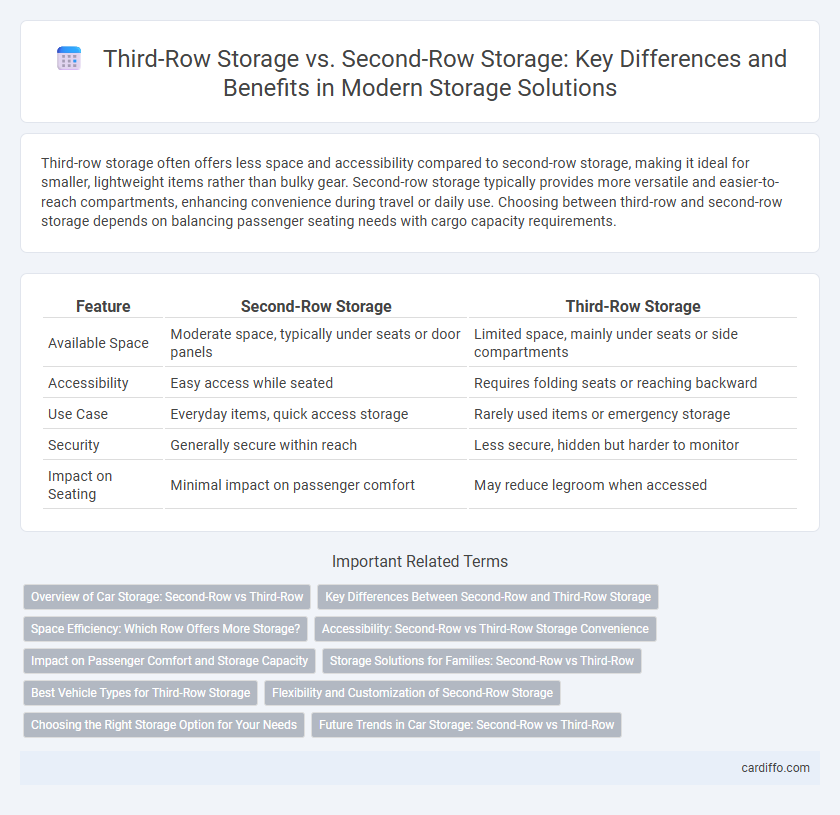Third-row storage often offers less space and accessibility compared to second-row storage, making it ideal for smaller, lightweight items rather than bulky gear. Second-row storage typically provides more versatile and easier-to-reach compartments, enhancing convenience during travel or daily use. Choosing between third-row and second-row storage depends on balancing passenger seating needs with cargo capacity requirements.
Table of Comparison
| Feature | Second-Row Storage | Third-Row Storage |
|---|---|---|
| Available Space | Moderate space, typically under seats or door panels | Limited space, mainly under seats or side compartments |
| Accessibility | Easy access while seated | Requires folding seats or reaching backward |
| Use Case | Everyday items, quick access storage | Rarely used items or emergency storage |
| Security | Generally secure within reach | Less secure, hidden but harder to monitor |
| Impact on Seating | Minimal impact on passenger comfort | May reduce legroom when accessed |
Overview of Car Storage: Second-Row vs Third-Row
Second-row storage in cars typically offers larger, more accessible compartments such as under-seat bins, door pockets, and center consoles, providing easier daily use for passengers. Third-row storage is generally more limited, with smaller pockets and less under-seat space, focused mainly on compact items due to narrower seat designs and reduced cabin space. Vehicles with fold-flat third rows enhance overall cargo capacity, bridging the gap between passenger seating and storage flexibility.
Key Differences Between Second-Row and Third-Row Storage
Second-row storage typically offers more capacity and easier access compared to third-row storage, which is often more compact and designed for occasional use. Second-row compartments provide greater versatility with features like sliding seats and under-seat bins, enhancing passenger comfort and cargo organization. In contrast, third-row storage focuses on maximizing space efficiency within limited dimensions, often sacrificing volume for extra seating options.
Space Efficiency: Which Row Offers More Storage?
Third-row storage generally offers less space efficiency compared to second-row storage due to its compact design and foldable seats designed primarily for passenger accommodation rather than cargo. The second row provides a larger, more accessible cargo area when seats are folded or removed, maximizing storage capacity for bulky items. Vehicles with adjustable or sliding second-row seats further enhance space utilization by allowing flexible configurations between passenger seating and storage needs.
Accessibility: Second-Row vs Third-Row Storage Convenience
Second-row storage offers superior accessibility, allowing easier reach to belongings without the need to bend or climb, which is often required for third-row compartments. Third-row storage, while providing additional space, can be less convenient due to its position, typically requiring passengers to fold or move seats to access items. Efficient vehicle design prioritizes second-row storage for frequently used items, enhancing overall convenience and ease of access.
Impact on Passenger Comfort and Storage Capacity
Third-row storage typically reduces passenger comfort due to limited legroom and cramped seating, impacting longer journeys negatively. Second-row storage offers greater accessibility and more spacious seating arrangements, enhancing overall passenger comfort. Additionally, second-row compartments maximize storage capacity without compromising seating space, making them ideal for both passenger and cargo transport.
Storage Solutions for Families: Second-Row vs Third-Row
Second-row storage solutions in family vehicles often offer more accessible compartments and larger under-seat bins, providing convenient organization for everyday items and child accessories. Third-row storage typically maximizes cargo space when seats are folded, allowing families to transport larger gear, but can be less practical for quick access during trips. Optimizing the balance between second-row easy-reach storage and third-row expanded cargo capacity enhances overall functionality for family travel and errands.
Best Vehicle Types for Third-Row Storage
SUVs and minivans excel in third-row storage, offering ample cargo space even when the third row is in use. Crossovers provide a balance of passenger capacity and storage, featuring fold-flat third-row seats to maximize cargo area. Full-size SUVs typically deliver the most generous third-row storage, benefiting families or groups needing versatile space for both passengers and luggage.
Flexibility and Customization of Second-Row Storage
Second-row storage offers superior flexibility and customization compared to third-row storage, allowing for adjustable seat configurations and enhanced cargo space management. Features like sliding, folding, and reclining seats in the second row enable tailored storage solutions to accommodate various passenger and cargo needs. This adaptability makes second-row storage ideal for maximizing available space without compromising comfort or accessibility.
Choosing the Right Storage Option for Your Needs
Choosing between third-row storage and second-row storage depends on your vehicle's layout and cargo requirements. Second-row storage typically offers easier access and larger space, ideal for bulky items and everyday use. Third-row storage suits vehicles with foldable seats, providing flexibility for occasional extra cargo without sacrificing passenger seating permanently.
Future Trends in Car Storage: Second-Row vs Third-Row
Future trends in car storage emphasize maximizing second-row seat flexibility through sliding and folding mechanisms, enhancing cargo capacity without compromising passenger comfort. Innovations in lightweight materials and modular designs allow second-row seats to transform into flat storage surfaces, providing more versatile space than traditional fixed third-row configurations. Advanced storage solutions also integrate smart compartment systems between second and third rows, optimizing accessibility and payload distribution for evolving urban and family transport needs.
third-row storage vs second-row storage Infographic

 cardiffo.com
cardiffo.com